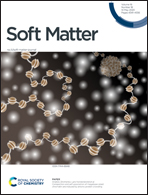Liposomal adhesion via electrostatic interactions and osmotic deflation increase membrane tension and lipid diffusion coefficient†
Abstract
Membrane adhesion is a ubiquitous phenomenon in cells and is related to various biological events such as migration, morphogenesis, and differentiation. To understand the physicochemical aspects of membrane adhesion, liposome–liposome adhesion and liposome–substrate adhesion have been studied. Although membrane adhesion has been shown to increase membrane tension and inhibit lipid diffusion, the relationship between these changes and the degree of membrane adhesion have not been quantified. Here, we analyzed the dependence of membrane tension and lipid diffusion on the degree of membrane adhesion, i.e., area fraction of the adherent region. For this purpose, we developed a simple method to prepare adhered liposomes by simple electrostatic interactions between the membranes and by osmotic deflation. We found that the membrane tension of the adhered liposomes increases slightly with an increase in the area fraction of the adherent region. In addition, the lipid diffusion coefficient of the adhered liposomes is larger than that of isolated liposomes, which is consistent with the theoretical prediction. The analysis provides a framework to understand the correlation between cell adhesion and bio-membrane properties such as membrane tension and molecular diffusion.



 Please wait while we load your content...
Please wait while we load your content...